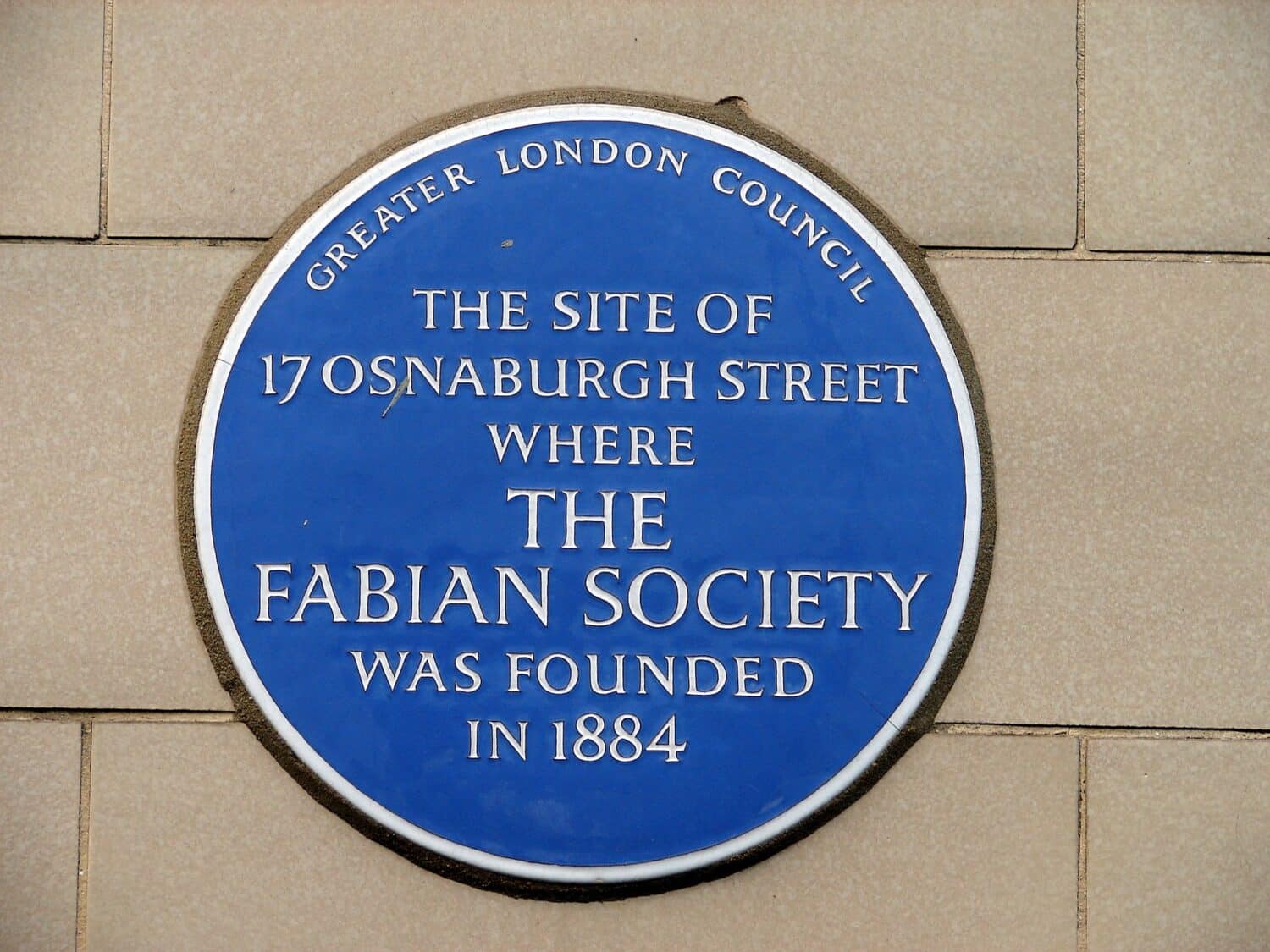Slow and Steady
Paul Richards looks back on 140 years of Fabianism
On 4 January 1884, a small group of earnest young men and women met at 17 Osnaburgh Street, just north of the Marylebone Road, to establish a new socialist society. There’s a blue plaque, if you wish to seek out the site. Like many of the political meetings I have attended in my life, they struggled to make double figures.
Just nine were present, including children’s author Edith Nesbit, Robert Owen’s granddaughter Rosamund Dale Owen, and Edward R Pease, who was also present at the founding of the Labour Representation Committee (LRC) six years later. They named their grouplet after Fabius Maximus, a Roman general famous for the avoidance of costly pitched battles, and the pursuit of steadily wearing down the enemy.
The Fabian Society was born from a frustration with its parent body, the Fellowship of the New Life, which the founding Fabians considered too ethereal, dislocated from the struggle, and hippy-dippy. Percival Chubb, one of the original nine, characterised these New Lifers as: “Marxists, Georgites, and Christian Socialists, as well as followers of Ruskin, Morris, and Emerson, spiritualists, psychic researchers, secularists, vegetarians, temperance advocates, and a variety of ethically-minded utopians.”
The Fabians kick-started the inevitable gradualness towards socialism with — what else — some resolutions. These are faithfully recorded in the book of minutes:
“Resolution I. — That the Society be called the Fabian Society. Carried by 9 votes to 2.
Resolution II. — That the Society shall not at present pledge its members to any more definite basis of agreement than that contained in the resolution of 23rd November, 1883. Carried unanimously.
Resolution III. — In place of Mr. Podmore’s first proposal it was eventually decided to modify the resolution of 7th November, 1883, by inserting the words ‘to help on’ between the words ‘shall be’ and the words ‘the reconstruction.’
Resolution IV with certain omissions was agreed to unanimously, viz.: That with the view of learning what practical measures to take in this direction the Society should:
(a) Hold meetings for discussion, the reading of papers, hearing of reports, etc.
(b) Delegate some of its members to attend meetings held on social subjects, debates at Workmen’s Clubs, etc., in order that such members may in the first place report to the Society on the proceedings, and in the second place put forward, as occasion serves, the views of the Society.
(c) Take measures in other ways, as, for example, by the collection of articles from current literature, to obtain information on all contemporary social movements and social needs.”
It’s not exactly the stuff of social revolution. Yet from these humble beginnings 140 years ago flowered the London School of Economics, the foundations and architecture of the welfare state, and myriad good ideas (and some bad ones) to fuel British democratic socialism.
To understand how, you have to see the Fabian Society in context. The last two decades of the 19th century saw a remarkable flowering of groups and associations dedicated to reforming and refashioning Victorian society. In these years we saw the birth or re-emergence of ideas which spoke to every aspect of the human condition. There were organisations dedicated to women’s rights and political participation, to the rights of children, to constitutional reform, to the promotion of free education, to animal rights and vegetarianism, to decent housing, against drink, gambling and tobacco, and towards a truly democratic society.
These two decades witnessed a new focus on the casualties of advancing capitalism, with Rev Andrew Mearns’ book The Bitter Cry of Outcast London (1883), WT Stead’s Maiden Tribute of Modern Babylon (1885), and Charles Booth’s Life and Labour in London (1891), which revealed a third of Londoners lived, and died, in filthy and degrading poverty.
There were riots and looting in Trafalgar Square, Pall Mall and Piccadilly in 1886, and the following year the ‘Bloody Sunday’ demonstration in Trafalgar Square turned to bloodshed (subsequently dramatized in William Morris’s News from Nowhere with his description of “dead and dying covered the ground, and the shrieks and wails and cries of horror filled all the air, till it seemed as if there were nothing else in the world but murder and death.”)
These progressive groups adopted the family Fabian methodology of evening lecture, summer school, committees, minutes and resolutions, with a subscription-paying membership. They also made time for ‘socials’, dances, singing and recitals. In 1888, Chants of Labour was published by George Allen and Unwin, with a cover and frontispiece by Walter Crane, a foreword by Edward Carpenter, and socialist songs and lyrics by Edith Nesbit, Havelock Ellis, Henry Salt, Jim Joynes, Bruce Glasier, and Walt Whitman.
They were urban, mostly London-based, and populated by the radically-minded middle-classes. They drew on older traditions of autodidacticism and self-help, and usually relied on a wealthy benefactor or two to pay for rooms, printing, and guest speaker expenses. An indication of the rich diversity of groups at the turn of the century is provided by the listings in the 1897 Labour Annual, an ecumenical ‘progressive’ book designed to draw together the disparate strands. The directory includes the Anti-Tobacconist League, the Bermondsey Socialist Club, Bradford Labour Church, the Church of England Temperance Society, the Co-operative Union, the Croydon Brotherhood Church, the Free Communist and Co-operative Colony, Freedom Anarchist-Communist Group, the Humanitarian League, the Liverpool Peace Society, the London Spiritualist Alliance, the London Vegetarian Society, the National Anti-Gambling League, the Social-Democratic Federation, and the Socialist Supper Club.
There was also a wide range of progressive women’s organisations, the co-operative movement, and the growing number of ‘new unions’ which grew from industrial unrest from mills to docks. As well as the Fabians, these years saw the founding of the Socialist Democratic Federation (1884), the Socialist League (1884), the Independent Labour Party (1893), and the Labour Representation Committee (1900).
London was awash with political refugees and revolutionaries, as well as radicals from across the empire. Mahatma Gandhi was a student at the Inner Temple between 1888–91, joined the Fabian Society, and sought out London’s vegetarian scene after reading Henry Salt.
The anarchists held their international congress in London in 1881 in Cleveland Street, London, with attendees including Peter Kropotkin. Lenin met Trotsky for the first time in London in 1902. In 1903, when the Russian revolutionaries split between Mensheviks and Bolsheviks, they held the fateful vote in a pub in Islington.
An earnest young person, who had started their political journey with Morris, Ruskin, Dickens, the Bible, or Henry George, could arrive in London and swiftly engage with a tapestry of radical and progressive groupings, serve on committees, meet luminaries like Wilde and Shaw, and perhaps even become a published pamphleteer and public lecturer. It wasn’t just the middle classes. These groups welcomed, and provided a platform for, the self-educated ambitious working-class person in ways few other bodies did, apart from the trade unions.
There was little tribalism, apart from on the Marxist and anarchist fringes, and no ‘party line’. This was before the baleful influence of Leninism and the strictures of ideological purity.
If you had the time and resources to spare, you could dedicate most nights and weekends to this swirling maelstrom of progressive causes. The problem with socialism, as Oscar Wilde is reputed to have said, is that it took too many evenings.
Into this ferment, the Fabians were born: passionate, quirky, sceptical, querulous, curious, dedicated, and unrelentless in the pursuit of social justice. One hundred and forty years later, we are still here.
This article also appeared on Paul’s blog.
Image credit: Simon Harriyott, CC BY 2.0 via Wikimedia Commons

